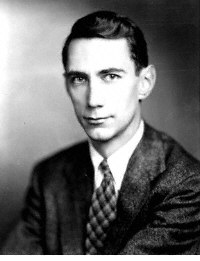|
|


 IBM's SSEC
IBM's SSEC
|
|
Computers
IBM's Selective Sequence Electronic Calculator computed scientific data in
public display near the company's Manhattan headquarters. Before its
decommissioning in 1952, the SSEC produced the moon-position tables used for
plotting the course of the 1969 Apollo flight to the moon.
| Speed: |
50 multiplications per second |
| Input/output: |
cards, punched tape |
| Memory type: |
punched tape, vacuum tubes, relays |
| Technology: |
20,000 relays, 12,500 vacuum tubes |
| Floor space: |
25 feet by 40 feet |
| Project leader: |
Wallace Eckert |

|
|
|
 Claude Shannon
Claude Shannon
|
|
Software & Languages
Claude Shannon's "The Mathematical Theory of Communication" showed
engineers how to code data so they could check for accuracy after transmission
between computers. Shannon identified the bit as the fundamental unit of data
and, coincidentally, the basic unit of computation.

|
|
|
 Norbert Wiener
Norbert Wiener
|
|
Robots & AI
Norbert Wiener published "Cybernetics," a major influence on later
research into artificial intelligence. He drew on his World War II experiments
with anti-aircraft systems that anticipated the course of enemy planes by
interpreting radar images. Wiener coined the term "cybernetics" from
the Greek word for "steersman."
In addition to "cybernetics," historians note Wiener for his analysis
of brain waves and for his exploration of the similarities between the human
brain and the modern computing machine capable of memory association, choice,
and decision making.

|

|
|

|
|
